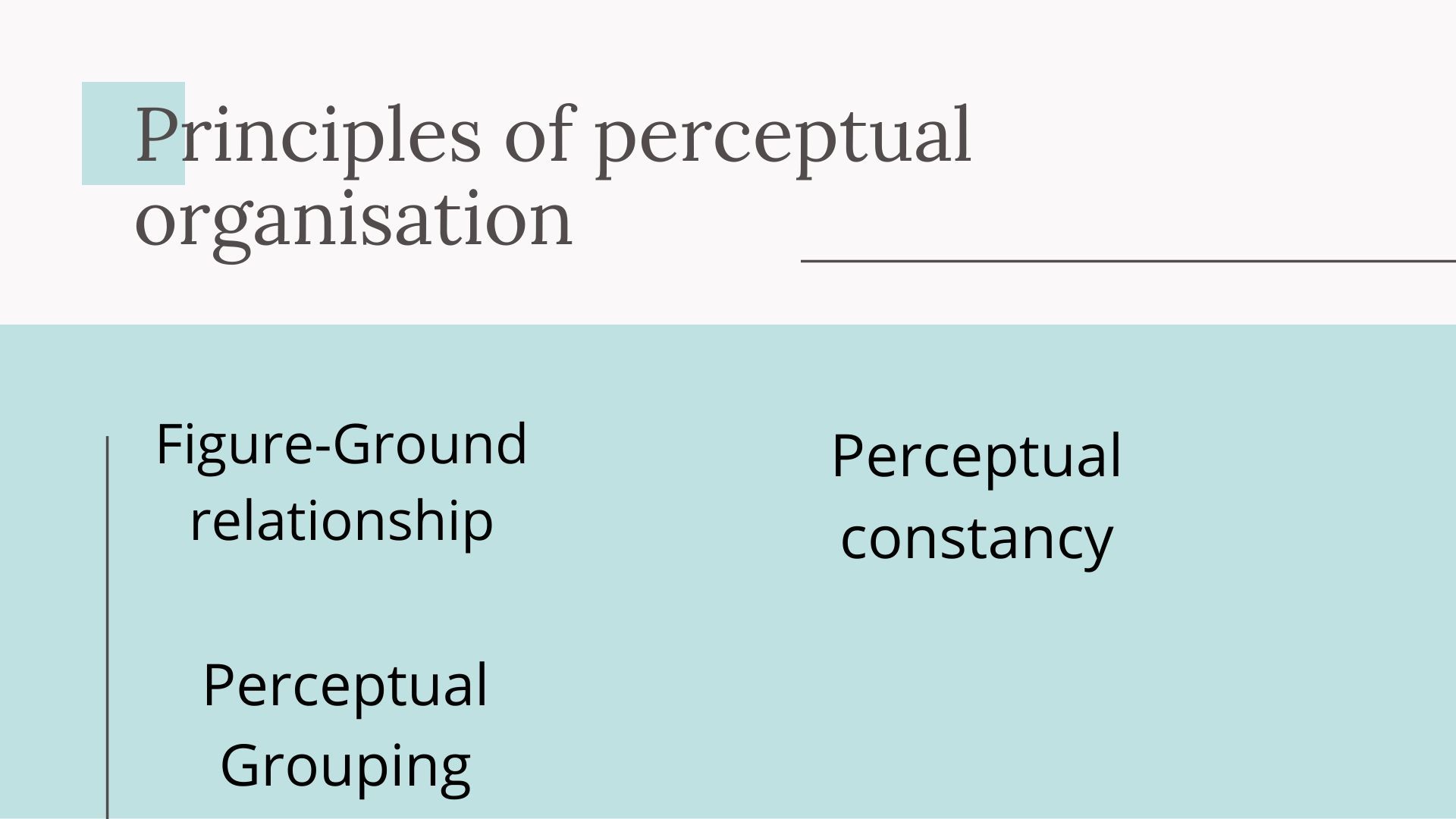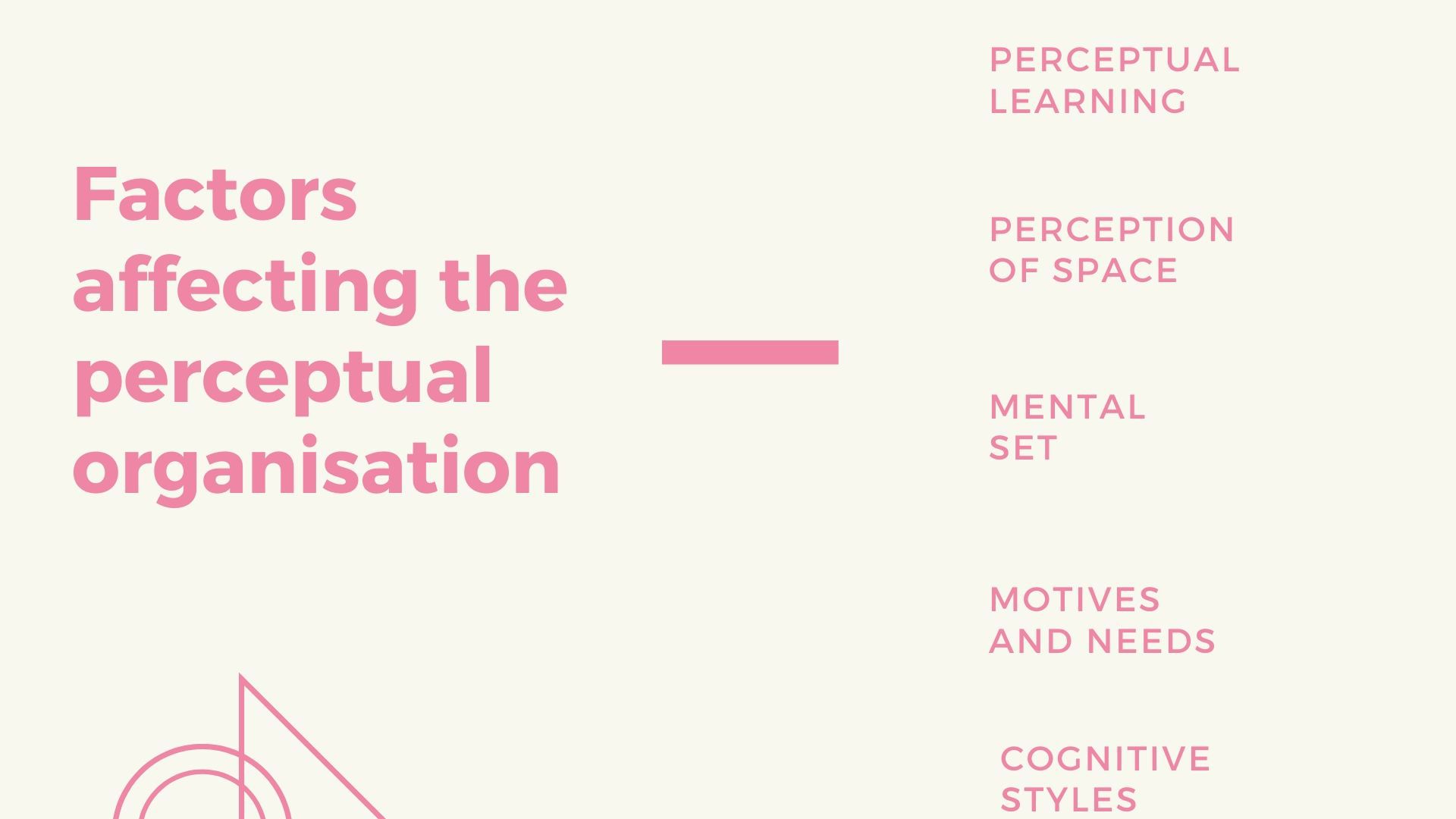
What is Perceptual Organization and What are its Principles?

Perceptual organization is the process of grouping visual elements to determine the meaning of the image as a whole It involves understanding the principles of organization and how factors like learning, perception of space, mental set, motives, and cognitive styles can affect the outcome
Perceptual organization refers to the process of grouping visual elements in a way that makes it easy to understand the overall meaning. This concept is crucial in enabling individuals to quickly make sense of what they see. Additionally, perceptual organization guides the viewer towards the most appropriate conclusion for our intended purpose.
What is Perceptual Organisation?
In our daily lives, we are constantly bombarded with various stimuli that activate our sense organs. These stimuli are then converted into sensations and transmitted to the relevant parts of our brain for interpretation. This process is what we call perception, which involves both sensation and interpretation.
Our perception is unique to us and is shaped by the information we have access to. This is why no two people view the same object in the same way. Perceptual selectivity considers both external and internal factors, while perceptual organization involves organizing incoming information into recognizable objects. It is a complex process that takes into account various psychological and physiological factors to ensure accurate perception.
Several principles or laws are at the forefront of the perceptual organisation theory, which explain how perception operates independently of individual stimulus features. It has been demonstrated that perceptual processes can be influenced by a range of factors beyond the characteristics of the stimulus itself. Thus, human perception is an active and complex process, subject to a variety of influences.
Understanding perceptual organisation
According to renowned American psychologist William James, humans tend to see objects not as they are, but as they want them to be. This process of perceptual organization involves the mind selecting certain stimuli and interpreting them based on personal preconceptions. Similarly, stimuli in the visual or audio field are selected and organized into a form that is more meaningful than its initial appearance.
The Gestalt psychologists were pioneers in explaining the perceptual organisation theory, which suggests that the human brain can create a conscious perceptual experience by processing the stimulus as a whole, rather than focusing on its individual parts. It is important to note that the stimulus plays a crucial role in this theory.
The Gestalt laws of perceptual organization theory are based on the following groups of rules or principles
The principle of figure-ground relationship states that our brain is capable of perceiving meaningful figures in the background, and what's fascinating is that these figures cannot be separated from the background they are perceived in. On the other hand, perceptual constancy refers to the human mind's tendency to perceive objects as stable and unchanging in size and shape despite any changes in the received picture. While perceptual constancy is influenced by various factors such as imagination, learning, cognitive styles, motivations, habits, expectancy, and experience, it can manifest in different forms, including size constancy, brightness and color constancy, and shape and size constancy.
The human mind has a natural tendency to group multiple stimuli together in a recognizable pattern, which is known as perceptual grouping. This principle is based on several factors, including closure, continuity, similarity, inclusiveness, pregnant, and proximity. The law of closure is a specific aspect of perceptual grouping that describes the human mind's ability to fill in gaps and perceive incomplete objects as meaningful wholes. According to Gestalt psychologists, when the human mind encounters unfinished or incomplete sensory information, it disregards the incomplete aspects and perceives the overall image or sound as a complete unit. This natural inclination is referred to as the law of closure.
When presented with an incomplete circle, the human mind tends to perceive it as a complete circle due to the law or principle of closure. This is because the mind strives to perceive objects in the simplest manner possible, as described by the Law of Pragnanz, also known as the Law of Simplicity or Law of Good Figure. Similarly, when presented with interconnecting rectangles, the mind will perceive them as rectangles, despite the presence of other shapes, because it is the simplest and easiest figure to identify in the brain, reflecting the completeness or fullness of the picture.
According to Gestalt psychologists, perceptual organization is a dynamic process that continues to evolve until the human mind perceives it as complete, meaningful, and easily comprehensible. This final state is known as a good gestalt. The law of pragnanz, which describes the underlying mechanisms of this process, includes the law of closure. For example, a child will continue to ask questions until their mind is satisfied and their perception of a particular thing is fully understood.
The law of proximity is a principle that explains how the human mind perceives objects that are near each other as if they are related. When objects are arranged in a certain way, the mind will group them together based on their proximity. For example, if six circles are drawn in a straight line with varying distances between them, the human mind will perceive them as two groups based on their proximity. This principle is a part of the perceptual organization theory and helps to explain how the mind groups visual information into meaningful patterns and entities.
The human mind has a natural tendency to group similar objects together and perceive them as a single entity, rather than as individual objects. This is known as the law of similarity and applies to both auditory and visual stimuli. According to the perceptual organisation theory, stimuli that share similar color, shape, and size are grouped together and perceived as a pattern.
Similarly, the law of continuity describes how our minds perceive objects that extend themselves into space in a continuous pattern of color, size, and shape. Rather than seeing separate lines or shapes, our minds perceive them as one entity if they are connected by a curving or straight line, without any breaks. This creates a sense of flow and continuity in our perception of the object.
The law of inclusiveness states that our minds tend to perceive objects within a pattern more easily than others. For instance, if you were to create a circle with big dots and a rectangle with smaller dots in the middle, the viewer's mind would focus on the outer dots of the circle more than the smaller ones within it. This is because the outer dots act as a fence or enclosure, making them more prominent and identifiable to the mind.
Factors affecting the perceptual organisation
The factors that affect the perceptual organisation are as follows-
1. Perceptual learning
Experience is the ultimate teacher when it comes to perceptual learning. Humans tend to focus on certain sensory inputs while disregarding others, especially if they have received specialized training in a particular field. For example, someone who is trained in a skilled profession like painting will have a deeper understanding of colors and art than individuals who lack such training.
A newborn baby relies on his perception to recognize his mother through her voice or scent. This ability is also present in blind individuals, who can identify people through their distinct sounds.
2. Perception of space
3. Mental set
Perceptual organization can be influenced by how the human mind perceives space. This means that when a person sees an object in their environment, they tend to perceive it in three dimensions: width, height, and distance.
Mental set is a critical element that plays a significant role in shaping perceptual organization. It is a state of mind that enables an individual to be receptive to sensory input, which helps them maintain the right level of attention and focus.
To illustrate this concept, consider the example of standing in a metro station. The sound of the train's horn alerts you to its impending arrival, and you prepare yourself accordingly. Similarly, when passing by a temple, the sound of bells ringing or the chanting of religious verses immediately informs you of the sacred nature of the place.
4. Motives and needs
Motives and needs play a significant role in the perceptual organisation theory. It is a well-established fact that a person's perception levels are impacted by their motives and needs. For instance, when a person is thirsty, they will immediately recognize water. This highlights the influence of one's needs on their perception.
The heightened state of awareness that comes with fasting also sharpens the senses, allowing a person to easily detect the aroma of food or quickly pinpoint the specific items they are looking for amidst a sea of options. This laser focus on satisfying one's basic needs and desires is a powerful motivator, driving individuals to seek out only what is necessary to sustain them in that moment.
5. Cognitive styles
Cognitive styles are known to have a significant impact on perceptual organization. The way in which an individual processes information can vary greatly based on their unique cognitive style. This is largely due to the fact that every person is inherently different, with their own distinct way of understanding and interpreting the world around them.
Studies have shown that individuals with flexible and outgoing personalities tend to have better attention spans. This is largely attributed to their self-assuredness, which allows them to remain focused and unaffected by external distractions. They are also less likely to be swayed by their own internal impulses and desires, distinguishing them from individuals who are more rigid and governed by their own personal needs and wants.









